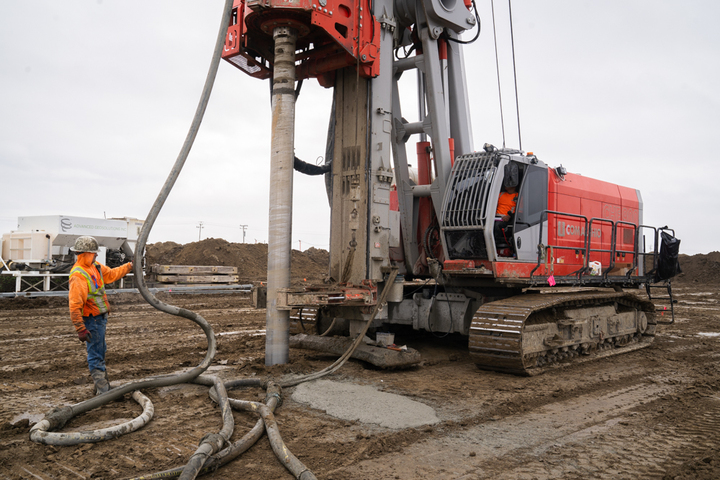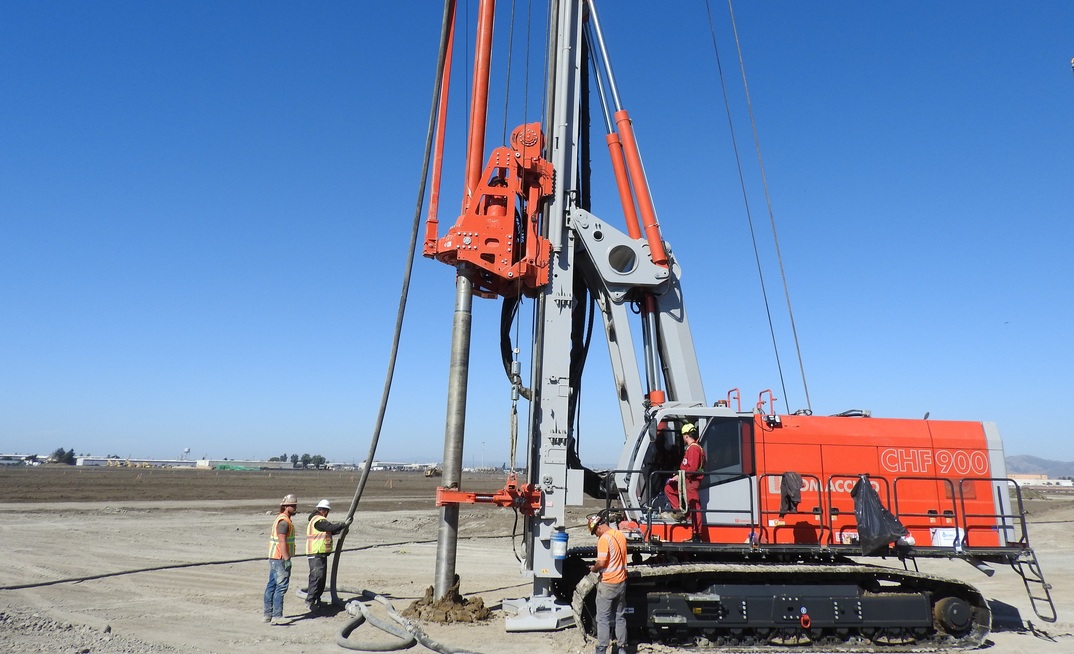The Amazon Project Goat in Salinas, California, represents a further step in the company's expansion strategy, setting the stage for what will be one of its largest warehouses in the US, serving the central coast.
When completed the five-storey distribution warehouse, over three million sq.ft in size, is expected to employ about 1500 people, with 260 delivery trucks going in and out daily. Designed to handle immense logistical demands, the site required a foundation solution capable of supporting high building loads while withstanding the seismic activity characteristic of Northern California.
Advanced Geosolutions Inc. (AGI), a design-build ground improvement and specialty piling contractor operating across the West Coast, Texas and Canada, was tasked with ensuring a stable foundation despite challenging soil conditions.
A tailored approach
AGI implemented a tailored approach that combined cement deep soil mixing (DSM) and displacement grouted columns (DGC). The ground improvement scope, initially planned for a six-month duration, demanded an accelerated timeline to meet Amazon's aggressive construction schedule. Rising to the challenge, AGI successfully completed its scope of work in just three months by mobilising additional resources and implementing efficient logistics strategies.
YOU MIGHT ALSO LIKE
Juan Baez, president and CEO at AGI, recalled the intensity of the undertaking. "The ground improvement columns were constructed using a sequential methodology that optimised the construction of the building foundations in subsequence with our work. From the outset, we knew this project would require an innovative approach.
"The ground conditions were highly variable—soft, compressible clays interbedded with zones of dense clays and sandy and slitty soils. A portion of the site (more than 20% of the building footprint) featured denser clays at shallow depths, leading to variations in ground conditions and early refusal levels during construction. A one-size-fits-all solution simply wouldn't work," he said
To navigate these complexities, AGI employed a seven-rig operation, installing over 1900 DSM elements (approximately 90,920 cubic yards / 69,500cu.m) and 4700 DGC elements (approximately 23,330 cubic yards/17,900cu.m) over the condensed timeline set out by Amazon—an effort that required the team to operate Monday through Saturday in close coordination with the general contractor, ensuring seamless integration of the foundation work with the overall construction timeline.
Subsurface variations
Cement deep soil mixing (DSM) and displacement grouted columns (DGC) technologies were implemented to address variations in subsurface conditions at the project site. DGCs were chosen for stiffer clays due to their ability to penetrate and displace the dense soil without the need for mechanical mixing, making them a more effective solution in these conditions. DSM was utilised in more compressible clay formations to enhance soil stability and mitigate geotechnical hazards present.
AGI's project marked the debut in the US of the Comacchio CHF 900, a powerful 90t class piling rig that was introduced into the US market through the collaboration of the Comacchio dealer Hammer & Steel. Chase Henri, senior project manager at AGI, explained: "AGI owns a Comacchio CH 650 and has used it in many different applications on various jobs, but for this specific project, we needed a rig that could achieve a single stroke depth of up to 105ft (32m). The CHF 900 has this capability thanks to the addition of a Kelly extension. Thus, we utilised the CHF 900 to drill the deepest holes, with a diameter exceeding 18ft (460mm)."
Given the high front-end weight of the drill string with Kelly extension, AGI operators had to exercise exceptional care in manoeuvring the rig between locations. "Safety was a top priority," Henri noted. "We ensured that every move was executed on a stable, level working platform, minimising risk while keeping pace with the demanding schedule."
Productivity metrics
The CHF 900 delivered impressive productivity metrics. The rig maintained a path with the accelerated overall project schedule, performing 15 to 25 piles per day depending on depth and ensuring that subsequent operations proceeded without delay.
AGI leveraged its proprietary displacement drilling methodology, which required precise coordination between drilling parameters and grout injection – capabilities that were seamlessly integrated into the CHF 900's standard settings.

The rig's advanced measurement and control systems were integrated with a Jean Lutz system implemented by Hammer & Steel, which further streamlined the process and enhanced performance monitoring, providing real-time data on the mast orientation, rpm, pumped volume, grout pressure, depths, as well as tool advancement and extraction rates.
"The capability to synchronise the concrete pump speed with the auger pull rate ensured precise control over the target average diameter while minimising cement overuse", Henri commented. "The intuitive data acquisition interface equipping the rig allowed for simple production data transfer and input changes. Overall, enhanced cab comfort and well-placed control screens improved operator efficiency by providing a seamless experience".
The CHF 900 had to lead the way running in front of the production of the rest of the piles
"Due to the project layout, the CHF 900 had to lead the way running in front of the production of the rest of the piles, so it was on a critical path and could not break down," recalled Daraius Tata, West Coast manager at Hammer & Steel, providing the rental of the equipment and solid support throughout the project. "Much of the time the rig was run on a double shift, with the H&S team ensuring availability for routine maintenance works during the weekends."
Meeting demands
The combination of innovative engineering, full-scale field verification testing, advanced drilling technologies, rigorous execution and top-notch support ensured that AGI's ground improvement system met this project's high specifications and demanding schedule. Beyond technical execution, the project underscored the importance of adaptability.
"AGI looks at all projects as custom jobs. That's why we take pride in being the premier design-build geotechnical contractor. The ground doesn't always consider the needs of your plans, but AGI does," concluded Riaz Jiwani, business development manager at AGI. "In this case, given the aggressive project schedule, we were able not only to refine our construction methodologies to the maximum but also to rapidly scale operations and allocate additional manpower, equipment, and logistical support without compromising safety or quality. A job completed with surgical precision by our entire operations and field teams".
Ground improvement installation at the Amazon site in Salinas commenced in September 2024 and was delivered by January 2025, with a phased construction handoff to allow for the early start of the building foundation. The city expects the multi-phase Amazon project to be completed in 2026, as the advent of the e-commerce giant will reorganise and transform the infrastructure in the southerly end of Salinas.



















